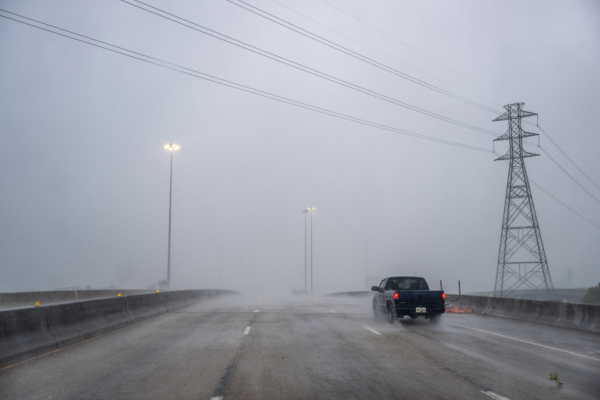Hurricane Beryl, the earliest-recorded Category 5 hurricane, made landfall near the coastal town of Matagorda, Texas on Monday (July 8th). As it moved inland, it brought dangerous storm surges, strong winds, and heavy rains to the coastal areas, resulting in power outages for nearly a million residents and the cancellation of over a thousand flights.
Beryl wreaked havoc last week as it swept through Jamaica, Grenada, St. Vincent, and the Grenadines, causing at least 11 fatalities and leaving a trail of collapsed buildings and power lines in its wake.
Having intensified into a Category 1 hurricane while traversing the warm waters of the Gulf of Mexico before landfall, Beryl is now expected to rapidly weaken, according to the National Hurricane Center (NHC).
The NHC stated, “Beryl is expected to weaken to a tropical storm later today and to a tropical depression by Tuesday. As the center moves inland, a steady and rapid weakening is expected.”
Located approximately 55 miles southwest of Houston, Beryl is moving at a speed of 12 mph towards the state’s eastern regions, where it is projected to hover overhead on Monday before advancing towards the lower Mississippi and Ohio River valleys on Tuesday and Wednesday.
Residents in the affected areas are facing life-threatening storm surges and heavy rainfall, with destructive winds lashing the coastal regions, as reported by the NHC.
Gary Short, a resident, expressed concerns about potential flooding as he filled up his gas tank at a station, stating, “I am most worried about the rain. Other than that, not too concerned. Just staying prepared.”
The impending storm led to the closure of major oil shipping ports near Corpus Christi, Galveston, and Houston, potentially disrupting crude oil exports, transportation of crude to refineries, and supply of gasoline from refineries.
Some oil producers, including Shell and Chevron, evacuated personnel from offshore platforms in the Gulf of Mexico ahead of the storm’s arrival.
Due to Hurricane Beryl’s strengthening and landfall in Texas, over 1,300 flights were canceled by major airlines on Monday.
As per data from FlightAware, a flight tracking website, a total of 1,331 flights were canceled, with 505 flights experiencing delays as of 6:06 AM. Southwest Airlines led with 406 cancellations, followed closely by United and Southwest Airlines with 268 and 233 cancellations, respectively.
Both United Airlines and Southwest Airlines issued travel advisories, citing impacts on flights at airports in Austin, Corpus Christi, Harlingen, and Houston due to Hurricane Beryl.
As of the NHC’s 6 AM update, Beryl maintained sustained winds of 80 mph, rotating approximately 55 miles southwest of Houston.
The hurricane-strength winds brought a surge in power outages, with nearly a million electricity customers in Texas reported to have lost power, according to Centerpoint Energy.
Wind gusts reached 91 mph in Freeport, 86 mph in Matagorda City, 81 mph in Palacios and Houston’s elevated station, 78 mph in Galveston, and 60 mph in Houston Intercontinental Airport.
Apart from previously issued hurricane warnings, storm surge warnings, and tropical storm warnings along the Texas Gulf Coast, tornado threats prompted the issuance of tornado warnings in the region.
Forecast indicates storm surges of 3 to 7 feet in some areas near Beryl, with seawater breaching the Texas coast and bays near Beryl. Measurements in Sargent and Matagorda Bay reached 3.2 feet and 2.6 feet, respectively, before some devices stopped reporting due to power outages.
Storm chaser Mark Sudduth reported, “Surge is coming up on Treasure Island. You can really see it moving in like a raging river now.”
The National Weather Service in Houston reported flash flooding in parts of the metropolitan area, with rain totaling 3 to 6 inches as of early Monday and expected to increase by 2 to 4 inches more. Flash flood warning encompassed millions of residents in the Houston and Galveston metropolitan areas.
As Beryl progresses northward, it is predicted to bring rainfall and strong winds to regions north of Michigan by the end of the workweek.
Beryl’s current forecast cone shows the storm will weaken as it moves northward but maintain tropical depression strength from Arkansas to Michigan throughout the week. A tropical depression refers to a cyclone with maximum sustained winds not exceeding 38 mph.
The Weather Prediction Center’s summary suggests the possibility of flash flooding from Tuesday to Wednesday in a region spanning from Arkansas to central Illinois.
Forming on June 29th and becoming the first hurricane of the season, Beryl rapidly intensified as it crossed the Atlantic into the Caribbean, setting several records along its journey.
Texas marks Beryl’s third and final landfall point, with the storm expected to deteriorate as it moves north across the United States.
Having already claimed at least 11 lives during its passage through the Caribbean, Beryl continues to pose a threat as it navigates its course through the United States.

